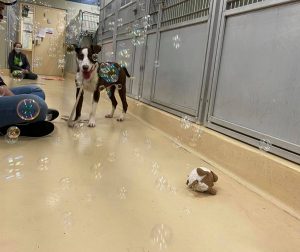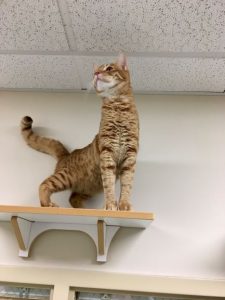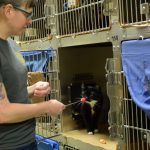How enrichment techniques help fearful pets blossom.
 What do bacon bubbles, audio books and bird videos have in common? They are all enrichment tools used in the Behavior Modification (BMod) Program at the Oregon Humane Society. The BMod team works with dogs and cats who come to OHS needing in-depth care to address their fears, anxiety, and other behavior challenges. Often, these animals come from neglect cases or situations where they received minimal care and little socialization.
What do bacon bubbles, audio books and bird videos have in common? They are all enrichment tools used in the Behavior Modification (BMod) Program at the Oregon Humane Society. The BMod team works with dogs and cats who come to OHS needing in-depth care to address their fears, anxiety, and other behavior challenges. Often, these animals come from neglect cases or situations where they received minimal care and little socialization.
One of the goals of the BMod program is to help animals learn to trust humans and be more relaxed in their kennels. Like people, building resilience is key to being able to cope with stressful situations and move past fears.
There are six categories of enrichment.
1. Training
 People love to solve problems and so do pets. Think about how popular escape rooms are for human entertainment. When you solve that puzzle, it increases your confidence and leaves you wanting to try more. Similarly, engaging an animal’s brain by teaching them cues like “sit” can build their resilience and trust with humans.
People love to solve problems and so do pets. Think about how popular escape rooms are for human entertainment. When you solve that puzzle, it increases your confidence and leaves you wanting to try more. Similarly, engaging an animal’s brain by teaching them cues like “sit” can build their resilience and trust with humans.
“Once you teach a scared, shut-down dog one thing, they think ‘I can learn’,” according to Annika Howland, Dog BMod Program Manager. “They feel like they have more control over things.”
Cats also benefit from training to help them overcome their fears. “Teaching a cat to target something using their paw or nose is a great way to provide enrichment for cats.” says Deborah Fitzgerrel, Cat BMod Program Specialist.
2. Social
Dogs and cats are social animals. Even a scared pet can benefit from quiet time with a person reading softly. Any neutral or positive interaction with a human helps break down the barriers of fear. For dogs who enjoy the company of other dogs, OHS staff uses a “helper dog” to help bring a scared dog out of their shell. “This social time with other animals can have a very healing effect,” says Annika. “We call them “Pod Parties.”
3. Manipulation
Animals love toys they can manipulate with their mouth, paws, and body. Activities that involve chewing, chasing, and biting gives them an opportunity to practice their natural behaviors and build confidence. When animals have a chance to solve a problem on their own it teaches them self-control and resilience.
4. Food
Food can be a great motivator and tool to help animals overcome their fears. The dogs in the BMod program at OHS use snuffle mats, frozen water bowls, kongs, puzzle toys and other materials to engage a pet’s brain and reward them with food. Food can be incorporated into any activity and allows pets to forage and practice natural behaviors. Anything involving food or mealtime can become an enrichment experience.
5. Environment
 Creating an enriching environment is key to helping pets build resilience by giving them the chance to be curious. Small, frequent changes like a new blanket or bed helps the BMod dogs at OHS engage their brain while exploring the new things in their environment. Cats are more territorial than dogs so giving them a spot to hide, perch or rub is important for their enrichment. Keeping cats indoors is the safest option so it’s important that they have window perches and a chance to look at something that is dynamic and changes frequently. The cats in the BMod program at OHS have tablets with bird videos and other scenes that resemble a window to a yard. They also have a variety of perches and furniture, donated by Square Cat Habitat, to keep their minds and bodies active.
Creating an enriching environment is key to helping pets build resilience by giving them the chance to be curious. Small, frequent changes like a new blanket or bed helps the BMod dogs at OHS engage their brain while exploring the new things in their environment. Cats are more territorial than dogs so giving them a spot to hide, perch or rub is important for their enrichment. Keeping cats indoors is the safest option so it’s important that they have window perches and a chance to look at something that is dynamic and changes frequently. The cats in the BMod program at OHS have tablets with bird videos and other scenes that resemble a window to a yard. They also have a variety of perches and furniture, donated by Square Cat Habitat, to keep their minds and bodies active.
6. Sensory
Sensory enrichment includes anything that engages a pet’s sense of smell, sight, touch, and smell. Audio books and bacon bubbles fall under this category as a soothing voice and floating bubbles can help calm a fearful pet and help build their resilience. Behavior specialists in the BMod program at OHS also use a variety of scents to infuse a sense of calm into the shelter environment.
For more ideas on enrichment activities that you can do with your pet, sign up for a virtual class or watch one of our informative webinars.










